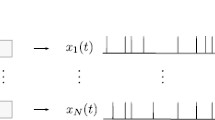Summary
The power spectral density of a modulated Poisson point process is derived, the results showing that modulation of the rate of the process introduces power only at those frequencies contained in the modulation, unlike the case of very “regular” carriers.
Signal transmission over multiple independent channels is briefly considered in terms of improving signal to noise ratio.
Some of the practical considerations of recovering modulation components are also considered in terms of sample size needed to achieve given levels of harmonic distortion.
Examples of the power spectra of the modulated discharges of the statocyst receptor neurons of the lobster (Homarus americanus) are presented, and are found to confirm the theoretical results.
The implications of the results for the significance of temporal patterning in neuronal discharges and the transmission of signals by neurons are discussed.
Similar content being viewed by others
References
Adrian, E. D., Zotterman, Y.: The impulses produced by sensory nerve endings. Part II The response of a single end-organ. J. Physiol. (Lond.) 61, 151–171 (1926).
Araki, T., Terzuolo, C. A.: Membrane currents in spinal motoneurones associated with the action potential and synaptic activity. J. Neurophysiol. 25, 772–789 (1962).
Bartlett, M. S.: The spectral analysis of point processes. J. roy. Statist. Soc. B 25, 264–287 (1963).
Bayly, E. J.: Spectral analysis of pulse frequency modulation in the nervous systems. IEEE Trans. on biomedical Engr. 15 (4), 257–265 (1968).
Brock, L. G., Coombs, J. S., Eccles, J. C.: The recording of potentials from motoneurones with an intracellular electrode. J. Physiol. (Lond.) 117, 431–460 (1952).
Cohen, M. J.: The function of receptors in the statocyst of the lobster Homarusamericanus. J. Physiol. (Lond.) 130, 9–34 (1955).
Coombs, J. S., Curtis, D. R., Eccles, J. C.: The electrical constants of the motoneurone membrane. J. Physiol. (Lond.) 145, 505–528 (1959).
Cox, D. R.: Some statistical methods connected with series of events. J. roy. Statist. Soc. B 17, 129–164 (1955).
Cox, D. R., Lewis, P. A. W.: The statistical analysis of series of events, chapt. 8. London: Methuen & Co., Ltd. 1966.
Doob, J. L.: Stochastic processes. New York: Wiley 1953.
Eccles, J. C., Ito, M., Szentágothai, J.: The cerebellum as a neuronal machine, p. 53. Berlin-Heidelberg-New York: Springer 1967.
Evarts, E. V.: Temporal patterns of discharge of pyramidal tract neurons during sleep and waking in the monkey. J. Neurophysiol. 27, 152–171 (1964).
Fatt, P., Katz, B.: An analysis of the end-plate potential recorded with an intracellular electrode. J. Physiol. (Lond.) 115, 320–370 (1951).
Gestri, G., Maffei, L., Petracchi, D.: Spatial and temporal organization in retinal units. Kybernetik 3 (4), 196–202 (1966).
Hagbarth, K.-E., Wolfhart, G.: The number of muscle-spindles in certain muscles in cat in relation to the composition of the muscle nerves. Acta anat. (Basel) 15, 85–104 (1952).
Hermann, H. T., Olsen, R. E.: Dynamic statistics of crayfish caudal photoreceptors. Biophys. J. 7, 279–296 (1967).
Knight, B. W.: Frequency response for sampling integrator and for voltage to frequency converter. In: Systems approach to neurophysiology problems. Minneapolis: Univ. of Minnesota Press 1969.
Knox, C. K.: An analysis of the discharges of Crustacean statocyst receptor neurons and their responses to sinusoidal rotations. Ph. D. Thesis, University of Minnesota (1969).
Kuffler, S. W., FitzHugh, R., Barlow, H. B.: Maintained activity in the cat's retina in light and darkness. J. gen. Physiol. 40, 683–702 (1957).
McKean, T. A., Poppele, R. E., Rosenthal, N. P., Terzuolo, C. A.: The biologically relevant parameter in nerve impulse trains. Kybernetik 6 (5), 168–170 (1970).
Mendell, L. M., Henneman, E.: Terminals of single Ia fibers: Distribution within a pool of 300 homonymous motor neurons. Science 160, 96–98 (1968).
Moore, G. P., Perkel, D. H., Segundo, J. P.: Statistical analysis and functional interpretation of neuronal spike data. Ann. Rev. Physiol. 28, 493–522 (1966).
Partridge, D. L.: Modification of neural output signals by muscles: A frequency response study. J. appl. Physiol. 20, 150–156 (1965).
Poppele, R. E., Bowman, R. J.: Quantitative description of the linear behavior of mammalian muscle spindles. J. Neurophysiol. 33, 59–72 (1970).
—, Terzuolo, C. A.: Myotatic reflex: Its input-output relation. Science 159, 743–745 (1968).
Rall, W.: Membrane time constant of motoneurones. Science 126, 454 (1957).
Rice, S. O.: Mathematical analysis of random noise. Bell Syst. Tech. J. 23, 282–332 (1944).
Stein, R. B.: Some models of neuronal variability. Biophys. J. 7, 37–68 (1967).
Terzuolo, C. A., Purple, R. L., Bayly, E., Handelman, E.: Postsynaptic inhibition. — Its actions upon the transducer and encoder systems of neurons. In: Structure and functions of inhibitory neural mechanisms, p. 261–275. New York: Pergamon Press 1968.
Thomas, J. B.: An introduction to statistical communication theory. New York: Wiley & Sons, Inc. 1969.
Weiss, T. F.: A model for the firing of auditory nerve fibers. M. I. T. Research Lab. of Electronics, Cambridge, Mass., Tech. Rpt. No. 418 (1964).
Author information
Authors and Affiliations
Additional information
Supported by P. H. S. Grants NB-2567 and NB-7421. Computer facilities were made available by a grant from the U. S. Air Force Office of Scientific Research, AF-AFOSB-1221. Partly in fulfillment of the requirements for the degree of Doctor of Philosophy, University of Minnesota, 1969.
The author is presently at The Nobel Institute for Neurophysiology, Karolinska Institutet, Stockholm 60, Sweden on a NIH Postdoctoral Research Fellowship (1 FO 2 NS 41662-01 NSRB) until 1 July 1970.
Rights and permissions
About this article
Cite this article
Knox, C.K. Signal transmission in random spike trains with applications to the statocyst neurons of the lobster. Kybernetik 7, 167–174 (1970). https://doi.org/10.1007/BF00289403
Received:
Issue Date:
DOI: https://doi.org/10.1007/BF00289403




